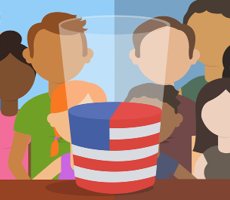- June 20, 2017
- By Liam Farrell
When Carol Graham was working on her new book, “Happiness For All? Unequal Hopes and Lives in Pursuit of the American Dream,” she at first had trouble believing her own data analysis.
The College Park Professor in UMD’s School of Public Policy crunched Gallup polling numbers and found that poor whites across the nation had become more pessimistic about their future than poor blacks or Hispanics, who have long been targets of discrimination.
“I thought it was a coding problem,” says Graham, who is also the Leo Pasvolsky Senior Fellow for the Brookings Institution’s Global Economy and Development Program.
It’s just one of several surprising discoveries in the book, which puts to the test a foundational American tenet—the right to life, liberty and the pursuit of happiness—in an era defined by income inequality and economic precariousness. Geoff Dyer at The Financial Times says it “pierces the myth that inequality is accepted in the U.S. because it is accompanied by so many success stories.”
The book examines U.S. trends in hope and optimism, as people who believe in a positive future are more likely to plan for it, from opening a savings account to exercising and quitting smoking.
“Hope matters, across the board,” Graham says.
Although income inequality has been increasing since the 1970s—some measures put the United States now on par with post-Soviet economies—American attitudes have only recently begun to crater.
In 2001, Graham says, a survey found that concerns about inequality were largely limited to liberal rich people; now, 61 percent of Americans believe the economic system favors the wealthy, and 62 percent think their children will be worse off than they are. She also found that the American gap between rich and poor in experiencing stress and believing that hard work gets you ahead was more extreme than in Latin America, a stereotypically unequal region.
Inequality is more important to people when they can grasp it on a local level. During the housing crisis, Americans across the country saw foreclosures in their neighborhoods contrasted with headlines about exorbitant CEO salaries.
“Beliefs are pretty ingrained. If you believe in something, you don’t fact-check it every day,” Graham says. “(The crash) made the local, global. Your personal problems were juxtaposed.”
Graham does not have definitive answers on why poor whites are more pessimistic about the future than other races, although she speculates that stronger religious faith, tighter community bonds and more resilience among African Americans and Hispanics from decades of hardship might play roles.
A paper she published this month also found that the decline in optimism among poor middle-aged whites matches alarming mortality spikes in the same population, driven by opioids, suicide and chronic illnesses like cirrhosis. For the first time in generations, Graham says, blue-collar whites believe they face a worse future than their parents had.
“It’s new for this cohort of people,” she says. “They don’t have the traditional framework for coping and they are in places where it’s harder to set those frameworks up.”
Graham believes more study is needed before definitive solutions are discussed, but she thinks local, community-organized efforts will play a critical role. She points to Huntington, W.Va., which has a new revitalization plan to develop abandoned factories, train out-of-work coal miners for new jobs, and attract tech and medical investment.
Growing up in Peru and researching in countries such as Burkina Faso, Graham has seen all varieties of deprivation. But she thinks, and her numbers bear out, that America’s poor might experience emotional hardships from endemic isolation and hopelessness that refrigerators, televisions and smartphones can’t solve.
“I’ve seen some pretty awful poverty,” she says. “There is something about poverty in the U.S. that is worse, even though, materially, people have more.”
Tags
Research